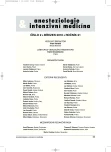Influence of age on the pharmacodynamic parameters of cisatracurium, rocuronium and vecuronium in males during total intravenous anaesthesia – a prospective study
Authors:
Adamus Milan
Authors‘ workplace:
Klinika anesteziologie a resuscitace, Fakultní nemocnice a Lékařská fakulta Univerzity Palackého v Olomouci
Published in:
Anest. intenziv. Med., 21, 2010, č. 2, s. 78-84
Category:
Anaesthesiology - Original Paper
Overview
Objective:
To compare the pharmacodynamics of cisatracurium, rocuronium and vecuronium following a single dose in young and elderly males during TIVA.
Design:
Clinical, prospective, controlled, randomized study.
Setting:
Department of Anaesthesiology, University Hospital.
Materials and methods:
Following ethics committee approval and patients’ informed consent, 240 males of two age groups (20–40, 60–75 years) received cisatracurium, rocuronium or vecuronium (2×ED95). For each patient, neuromuscular monitoring (TOF, electromyography) determined the onset time (maximal T1 depression), clinical duration (25% recovery of T1) and full recovery (TOF-ratio ≥ 0.9). Mann-Whitney or Kruskal-Wallis test were used to compare the differences between young and elderly patients.
Results:
The median onset times (seconds) were 205 vs. 255* for cisatracurium, 95 vs. 133* for rocuronium and 210 vs. 250* for vecuronium in the young and elderly patients, respectively (*p < 0.001). The median clinical duration (minutes) was 44 vs. 43.5 (p = 0.568) for cisatracurium, 36 vs. 58* for rocuronium and 32 vs. 60* for vecuronium in the young and elderly patients, respectively. Finally, the median full recovery times (minutes) were 71 vs. 77 (p = 0.095) for cisatracurium, 60 vs. 103* for rocuronium and 56 vs. 92* for vecuronium, in the young and elderly patients, respectively.
Conclusion:
The onset was slower in the elderly. Both clinical duration and full recovery for rocuronium and vecuronium were longer in the elderly whereas these parameters for cisatracurium were age-independent.
Keywords:
pharmacodynamics – cisatracurium – rocuronium – vecuronium – age
Sources
1. Servin, F., Cazalaa, J. B., Levron, J. C. Propofol, Sufentanil, Remifentanil in TCI. Bibliographical study of anesthetic agents used in the Base Primea®, Fresenius Vial. Le Grand Chemin, Brezins (France): Fresenius Vial, 2003.
2. Fuchs-Buder, T., Claudius, C., Skovgaard, L. T., Eriksson, L. I., Mirakhur, R. K., Viby-Mogensen, J. Good clinical research practice in pharmacodynamic studies of neuromuscular blocking agents II: the Stockholm revision. Acta Anaesthesiologica Scandinavica, 2007, 51, p. 789–808.
3. Adamus, M., Belohlavek, R. Fuzzy control of neuromuscular block during general anesthesia – system design, development and implementation. International Journal of General Systems, 2007, 36, p. 733–743.
4. Mencke, T., Soltesz, S., Grundmann, U. et al. Time course of neuromuscular blockade after rocuronium. A comparison between women and men. Anaesthesist, 2000, 49, p. 609–612.
5. Adamus, M., Gabrhelik, T., Marek, O. Influence of gender on the course of neuromuscular block following a single bolus dose of cisatracurium or rocuronium. European Journal of Anaesthesiology, 2008, 25, p. 589–595.
6. Murphy, G. S. Residual Neuromuscular Blockade: Is It A Problem In The Geriatric Patient? Sborník abstrakt, Kongres Perioperative Care For The Geriatric Patient. Praha, 14.–16. červen 2009. CD-ROM.
7. Sieber, F. E., Pauldine, R. Anesthesia for the Elderly. In Miller, R. D. (editor). Miller’s Anesthesia. Philadelphia: Churchill--Livingstone, 2005, p. 2435–2449.
8. Lien, C. Nondepolarizing Neuromuscular Blocking Agents in the Elderly: Dosing Paradigms Revisited. Sborník abstrakt, Kongres Perioperative Care For The Geriatric Patient. Praha, 14.–16. červen 2009. CD-ROM.
9. Han, D. W., Chun, D. H., Kweon, T. D., Shin, Y. S. Significance of the injection timing of ephedrine to reduce the onset time of rocuronium. Anaesthesia, 2008, 63, p. 856–860.
10. Szmuk, P., Ezri, T., Chelly, J. E., Katz, J. The onset time of rocuronium is slowed by esmolol and accelerated by ephedrine. Anesthesia and Analgesia, 2000, 90, p. 1217–1219.
11. Hans, P., Welter, P., Dewandre, P. Y., Brichant, J. F., Bonhomme, V. Recovery from neuromuscular block after an intubation dose of cisatracurium and rocuronium in lumbar disc surgery. Acta Anaesthesiologica Belgica, 2004, 55, p. 129–133.
12. Schmith, V. D., Fiedler-Kelly, J., Phillips, L., Grasela, T. H. Jr. Prospective use of population pharmacokinetics/pharmacodynamics in the development of cisatracurium. Pharmaceutical Research, 1997, 14, p. 91–97.
13. Anaesthesiology and Intensive Care in the Czech Republic 2007 [online]. [Cit. 26. 10. 2009]. Dostupný na WWW:
Labels
Anaesthesiology, Resuscitation and Inten Intensive Care MedicineArticle was published in
Anaesthesiology and Intensive Care Medicine

2010 Issue 2
Most read in this issue
- The effect of transversus abdominis plane block on post-operative pain relief: a prospective audit
- Multimodal monitoring in neurointensive care of severe traumatic brain injury
- Tomas Kadlic Memorial – Ass. Prof. Tomas Kadlic, M. D.
- Influence of age on the pharmacodynamic parameters of cisatracurium, rocuronium and vecuronium in males during total intravenous anaesthesia – a prospective study
